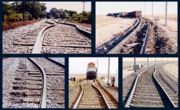
Rail stressing
Encyclopedia

Technique
Unconstrained large sections of steel will shrink as the temperature drops and expand as it increases. Since the ends of CWR are fixed the rail will experience tensile stress in extreme cold and can fractureFracture
A fracture is the separation of an object or material into two, or more, pieces under the action of stress.The word fracture is often applied to bones of living creatures , or to crystals or crystalline materials, such as gemstones or metal...
if it grows too great. In extreme heat, it will experience compressive stress and if that force grows too strong, the rail will buckle.
Imagine a length of CWR 1 kilometer long on track that has some stress in it. Each end of that rail is fixed to the track. Also imagine a 1 kilometer long length of rail lying on the ground next to the track. In a hot summer, the unconstrained rail lying next to the track is going to expand, and the rail fixed to the track will experience compression. The unconstrained rail will actually be longer than 1 kilometer. Likewise, in extreme cold, the unfixed rail will shrink and actually be shorther than 1 kilometer, while the rail that is constrained to 1 kilometer will experience tension.
Obviously, there is a temperature where the length of the rail as fixed on the track is equal to the length of the unfixed rail. This is known as the rail neutral temperature. Note that rail neutral temperature does not actually measure the temperature of the rail. Instead it measures stress because rail neutral temperature is merely the ambient air temperature where the fixed length of rail has no compressive or tensile stress.
When working with rail (laying new track, repairing track, changing out sleepers/ties
Railroad tie
A railroad tie/railway tie , or railway sleeper is a rectangular item used to support the rails in railroad tracks...
), this rail neutral temperature can be induced even if the ambient temperature is different by adding stress to the rail.
The act of stressing rail is inducing the proper rail neutral temperature so that there will be no fracturing or buckling at the temperature extremes. Since environmental extremes will vary, there is no universal rail neutral temperature. In the UK all rail is stressed to 27 degrees Celsius (81 Fahrenheit) (mean summer rail temperature). US standards range from 90 to 110 degrees Fahrenheit (35 to 43 Celsius) depending in large part on expected temperature range over the course of a year.
Stress is frequently induced when a piece of rail is removed (a defective rail) or when an IBJ
IBJ
IBJ may refer to:*Insulated block joint: rail joint incorporating insulation to isolate individual track circuits*The Industrial Bank of Japan, Ltd: Japanese bank, one of the predecessors to Mizuho Financial Group...
(Insulated Block Joint) is to be replaced. In these cases: The rail is marked and clips removed. The start point of the new rail is then cut. At this point the rail should shrink (a gap is created) due to the stress being lost in the rail. The technician then calculates how much stress is lost and needs replacing. The second cut is made and the old rail removed. The new rail is fitted and welded at one end. A stressing kit is then fitted at the end still to be welded. The kit is clamped to the rail and it pulls the gap together, leaving space for the second weld. Once the rail is stressed to the appropriate temperature the weld is made. After setting the weld the stress kit is removed.
The stress or neutral rail temperature of track can change over time, particularly under heavy traffic conditions. Besides resetting the rail neutral temperature when making repairs, rail testing is often employed to attempt to calculate the rail neutral temperature of a particular track to determine if prescriptive measures are needed.
External links
- Track Buckling Research in CWR from US DOT's Volpe Center Link is broken

